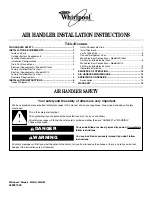
50
18-GJ06D2-2E-EN
O
OD
D T
Tw
wo
o S
Stta
ag
ge
e ((c
co
oo
olliin
ng
g m
mo
od
de
e))
1.
R-Y1 contacts close on the comfort control sending
24VAC to Y1 terminal on the AFC. The AFC
communicates to the EVC to control superheat for
1st stage.
2. Normally closed contacts on the AFC will pass
24VAC to the YO terminal providing power to the
outdoor unit 1st stage control circuit.
a. H
He
ea
att p
pu
um
mp
p OD > R-O contacts close on the
comfort control sending 24VAC to the O
terminal of the AFC. The AFC communicates to
the EVC that the system is in cooling mode. The
O signal is passed through to the OD unit.
b. N
No
on
n--H
He
ea
att p
pu
um
mp
p OD > OD dip switch
configuration will communicate to the EVC to
control superheat on a Y only signal.
3. R-G contacts close on comfort control sending
24VAC to the G terminal of the AFC.
4. The AFC micro-processor sends a command to the
serial communicating blower motor to run at the 1st
stage cooling cfm. (1st stage cooling cfm is a
multiplier of 2nd stage cfm)
5. The EVC will receive input from the two
temperature sensors and start to control 1st stage
superheat.
6. R-Y2 contacts close on the comfort control sending
24VAC to Y2 terminal on the AFC. The AFC
communicates to the EVC to control superheat for
2nd stage.
7.
The Y2 signal is passed through to provide power
to the outdoor unit 2nd stage control circuit.
8. The blower motor will now run at 100% of the
cooling cfm.
E
Elle
eccttrriicc H
He
ea
att
1.
R-W contacts close on the comfort control sending
24VAC to W1 of the AFC.
2. R-G contacts close on the comfort control sending
24VAC to G of the AFC.
3. The AFC communicates to the EHC that 1st stage
electric heat is being called upon.
4. The EHC determines the number of elements that
are used for 1st stage and sends a message to the
AFC for that correct cfm. (The EHC determines the
amount of heat per stage by either factory
programming or by the kw jumper position)
5. The AFC micro-processor sends a command to the
serial communicating blower motor to run and
close the blower interlock relay on the EHC. The
blower motor will now run at the W1 electric heat
cfm.
6. On subsequent calls for W2 and/or W3, the EHC will
communicate to the AFC the required airflow
request and energize the additional relays.
N
No
otte
e:: The EHC has "lead-lag" logic built in that
energizes the electric heat relays based upon
cycle counts.
For example: BAYEV**15 – The first time W1 only is
energized; the K1 relay would close and energize the
"A" heater. The second time W1 only is energized; the
K2 relay would close and energize the "B" heater. The
third time W1 only is energized; the K3 relay would
close and energize the "C" heater.
D
De
effrro
os
stt
1.
The OD unit will initiate defrost and send 24VAC to
the O terminal of the AFC.
2. The AFC will communicate to the EVC that the OD is
in defrost and the EVC will start to maintain the
correct superheat.
3. X2 from the OD will send 24VAC to W1 of the AFC.
4. The AFC communicates to the EHC that 1st stage
electric heat is being called upon.
5. The EHC determines the number of elements that
are used for 1st stage and sends a message to the
AFC for that correct cfm.
O
Op
pttiio
on
na
all C
Co
on
nd
de
en
nssa
atte
e S
Sw
wiittcch
h
1.
An optional OEM condensate switch can be
installed within the unit. This switch is only
available through the National Distribution Center
or Global Parts.
2. Switch contacts are normally open and close when
water level rises. The closed switch will interrupt
current flow to the YO terminal and de-energize the
OD unit.
3. Switch is only operational during cooling mode.
Condensate overflow is not operational during
heating or defrost modes.
Standard aftermarket condensate switches cannot be
used within the unit but can be installed on exterior of
the unit. The 3rd party condensate overflow switch
must be wired between Y of the thermostat and YI of
the AFC control.
F
Frre
ee
ezze
e P
Prro
otte
eccttiio
on
n
1.
The EVC control has the ability to sense when the
coil is beginning to ice. When this event occurs, the
contacts to the YO circuit will open and de-energize
the OD unit.
2. The indoor blower motor will continue to run to aid
in defrosting the coil. After 5 minutes, the YO
contacts will close and cooling operation will begin
again.
B
Bllo
ow
we
err D
De
ella
ay
ys
s
1.
Blower delays can be set to enhance system
efficiency. See S2 dip switch settings table.
T
TA
AM
M7
7 S
Se
eq
qu
ue
en
nc
ce
e o
off O
Op
pe
erra
attiio
on
n



























